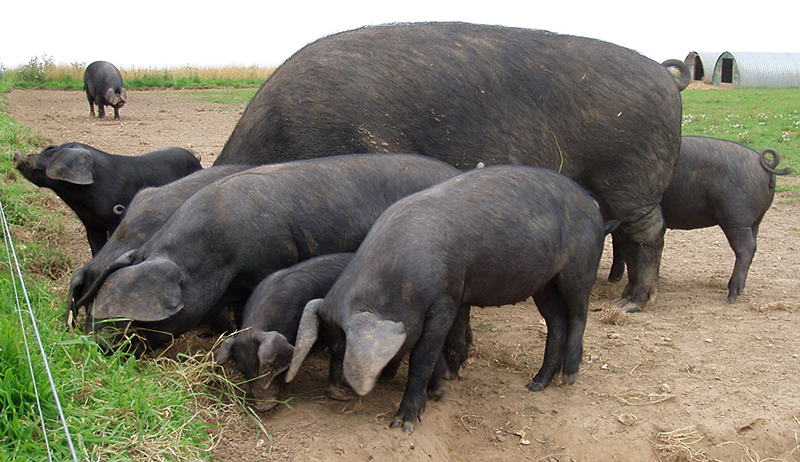
Pig feed conversion is a topic that can be confusing for new and experienced pig farmers. The basics are that pigs can loosely be lumped into two classes, bacon pigs and lard pigs. It’s important to know which is which before you get started.
Upon entry into the pig-purchasing arena, today’s new and prospective hog farmers are met with a kid-in-candy-store scenario: The slow food movement, along with a surge of interest in heritage breeds, has made buying starter pigs a venture worthy of some study and forethought.
Some years back, we came upon the opportunity to acquire a litter of Large Black piglets. Large blacks are firmly a heritage breed, defined loosely as a breed that has fallen out of favor with producers over the years but is of interest to farmers and customers for their pasturing and foraging abilities, distinct flavor profiles and general preservation. Which is to say they’re different—and the opportunity to raise uncommon animals prompted us to buy all five and a Gloucestershire Old Spots (an even rarer pig that slipped onto the endangered list at one point) to boot. We grew our uncommon hogs out on a ration of high-protein, hand-mixed feed, reveling all the while in the sight of our uncommon animals lazily occupying the pastures we rotated them between. To our minds, the extra effort was sure to pay off in some as-yet-unidentified manner.
So we were of course befuddled when the vacuum-packed cuts we received from our processor fell far short of the weight we’d come to expect. And we were disappointed when customer feedback yielded such comments as, “That little pork chop sure was fatty.”
And this is how we learned the all-important first lesson in our lifelong education on the sprawling topic of feed conversion efficiency: We’d raised a litter of lard pigs.
What is Pig Feed Conversion Efficiency?
Feed conversion efficiency is something of an unwieldy topic, full of numerous interconnecting factors, but the basic concept is simple: When a pig eats, the resulting muscle gain roughly determines the feed conversion efficiency. If a pig requires a lot of feed to gain muscle, the efficiency is low; less feed required to achieve muscle gain is high efficiency. And the key term here is “muscle”—if a pig converts feed into excessive fat (i.e., not meat), you’ll leave the processor as unhappy as we were.
If you want to raise a herd of heritage pigs to keep a breed from extinction, feed conversion efficiency won’t be a primary concern. But if you’re trying to manage costs and keep market profits in the black, bacon pigs are definitely the way to go, and you should stay away from lard pigs.
Here’s a quick breakdown of bacon pigs and lard pigs, though be aware each pig is its own animal: You can get a fat Yorkshire, just as I’m sure somebody’s raised a buff Large Black. However, generally speaking, here’s where a few popular breeds land on the bacon vs. lard pig spectrum of conversion-efficiency metrics.
4 Lard Pig Breeds
1. Gloucestershire Old Spots: Known as “apple pigs” for their traditional use cleaning up fallen apples in orchards of yore, these pigs are the oldest breed of spotted pigs around today. GOSs pack on the fat, and they have a tendency to be stubborn.
2. Large Black: There’s a lot to love about the Large Black, such as its sunburn immunity and calm disposition, but that love can die at the processor, where meat yields can fall below expectations.
3. Mangalitsa: The Mangalitsa is a weird-looking pig. But not in a bad way—its thick, wooly coat is almost sheep-like compared to other popular pigs. It’s also firmly a lard pig, with much lower pork yields than other breeds.
4. Guinea Hogs: This pig grows fast on whatever you feed them, but much of that conversion results in fat, not muscle. Raise this pig for its foraging abilities, not its profit potential at the local farmers’ market.
4 Bacon Pig Breeds
1. Tamworth: One of the oldest breeds, traceable back to the domestication of wild hogs, the Tamworth was specifically bred for bacon—it has long, deep sides that curers prefer—but the hog’s wild ancestry makes it a frequent flight risk.
2. Berkshire: I’ll be honest—this is my favorite pig (and it’s what we raise on our farm). The oldest recorded British pig, this animal has just enough fat marbling to add moisture and flavor to a cut of pork. With a distinctly “porky” taste, this animal is often brought in to add flavor to a line that’s lost palate appeal.
3. Hampshire: Sporting a distinct white belt that crosses its shoulders, the Hampshire also boasts hardiness, vigor, breeding proficiency and a knack for foraging. It’s also a lean pig, reliably able to yield predictable amounts of market-ready pork chops.
4. Yorkshire: Sometimes called the Large White, this pig is hands down the most popular breed in the world. While the commercial pork industry is reliant on this breed for its excellent conversion rate, small producers can also benefit from the lean pig’s pork yield, though it’s worth mentioning that muted flavor is sometimes an issue, due to the extreme lack of fat.
This article about pig feed conversion was written for Hobby Farms magazine. Click here to subscribe.




